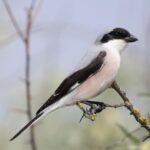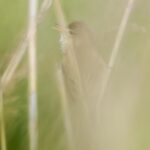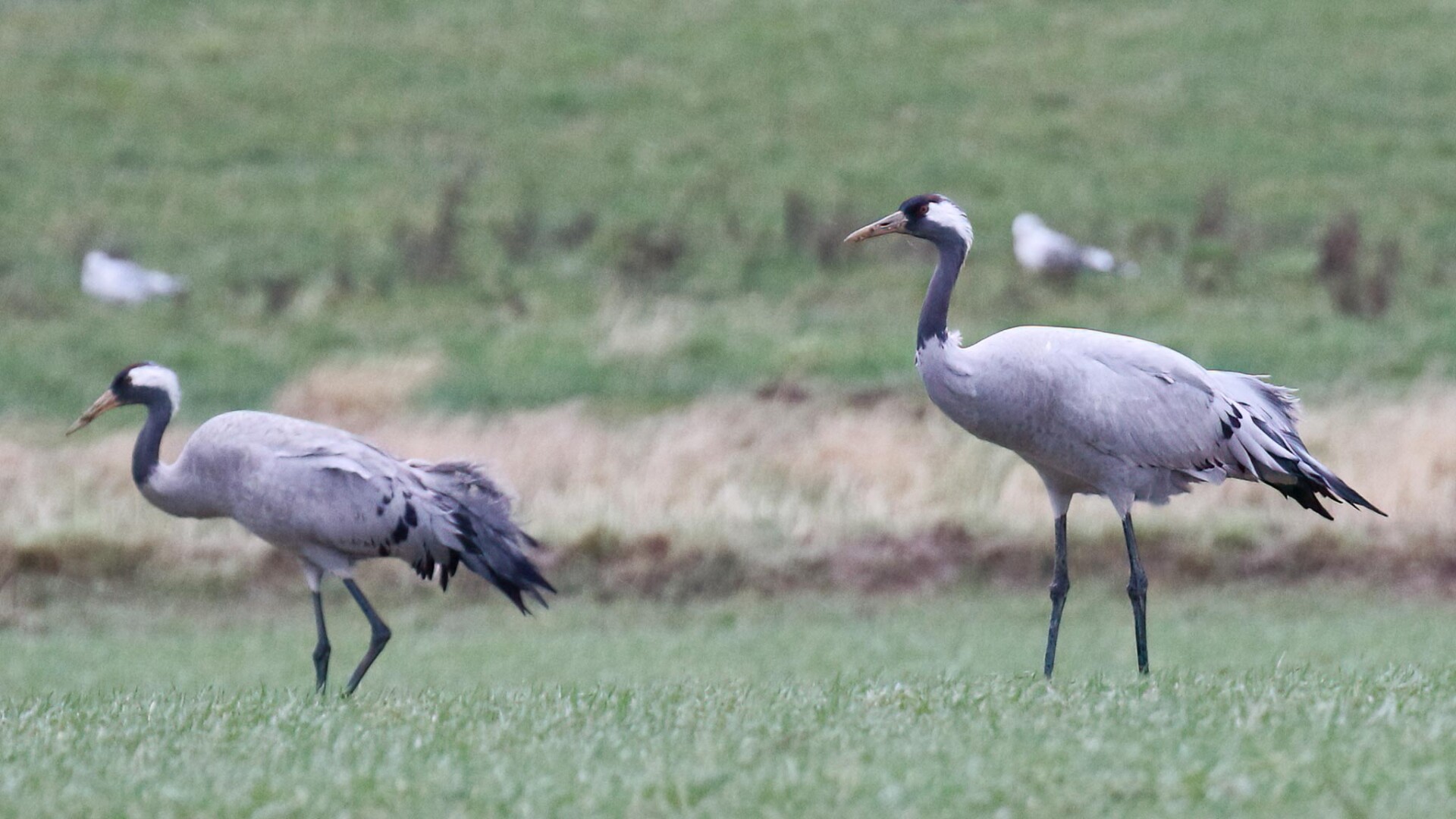A Private Tour today, down in Suffolk to look for and listen to Nightingales singing this morning, then back into Thetford Forest in the afternoon. It was a foggy start to the day, but thankfully the fog cleared just as we arrived. Bright and sunny during the morning, it clouded over progressively by the afternoon, but thankfully the showers held off until after we had finished for the day.
As we parked up and got out of the vehicles, a Blackcap was singing in the trees beside us. The melodic, fluted tones of a Nightingale singing just carried to us from the top of the hill, our main target for the day, so we decided to head up that way first. A Jackdaw was ripping at a large piece of discarded paper in the grass, presumably gathering litter as nest material.
A the top of the hill, a Yellow Wagtail called once as it flew over. Two Chiffchaffs were flitting round in a mostly bare oak, the leaves only just starting to emerge. Three Blackcaps were chasing round between the trees, two males and a female, the former presumably arguing over the affections of the latter.
A little further along, we heard the Nightingale again, but it was only half singing and in a fenced off area, so there would be no chance of seeing it. We stopped to listen to it for a few seconds, then as it moved further back, we carried on. We found another Nightingale singing from a dense area of brambles and bushes where we can often see them, so we stopped again to listen. A Willow Warbler was singing here too, its distinctive descending scale.
The Nightingale went quiet, and the next thing we knew it sang briefly behind us. We turned and just caught it silhouetted on the outside of a hawthorn, before it dropped down out of view. It seemed to go down close to the main path, so we walked round out of the bushes, but a dog walker was just ahead of us and the Nightingale then started singing again back in the bushes.
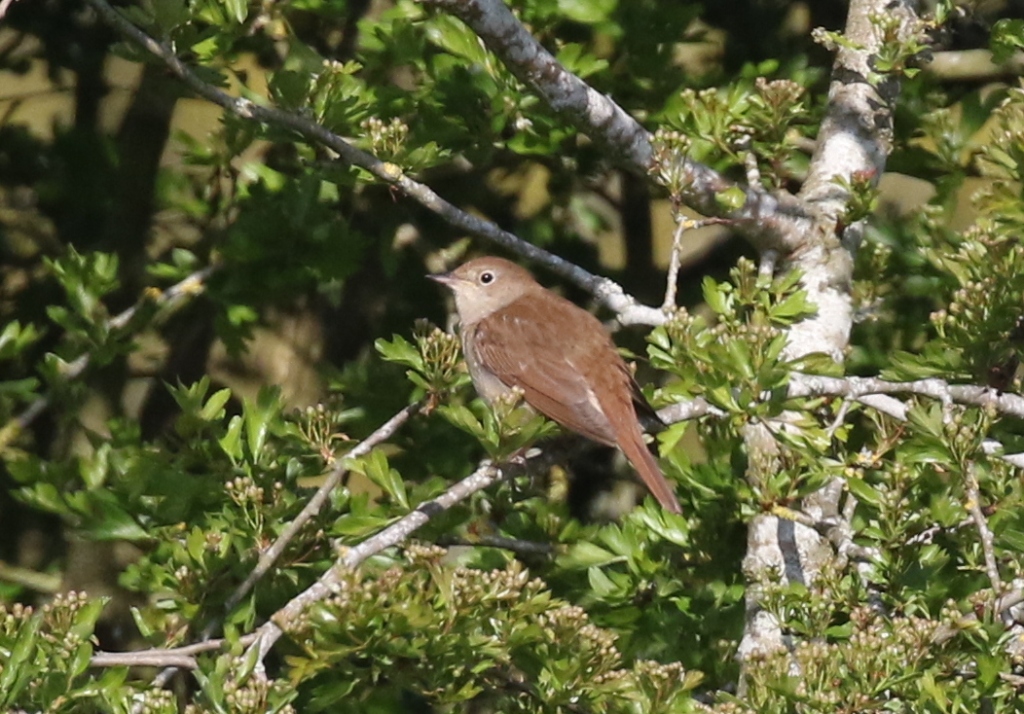
We stood out in the open and listened to the Nightingale singing. It was moving around as it sang, and then suddenly it appeared on the outside of a leafy hawthorn in front of us. We got in the scope and had a great view of it, perched face on to us, singing in the sunshine. It turned back on and fluffed up its feathers a little, probably warming up in the sunshine, still singing on and off.
It dropped down back into the bush out of view, and we thought that might be it, but after a minute or so the Nightingale appeared on the outside again. More great scope views followed, as it stayed singing in full view for a good time. Then it flicked back in and, with a flash of its bright rusty tail, it was gone. We stood listening to it still singing but from back deeper in the bushes again now.
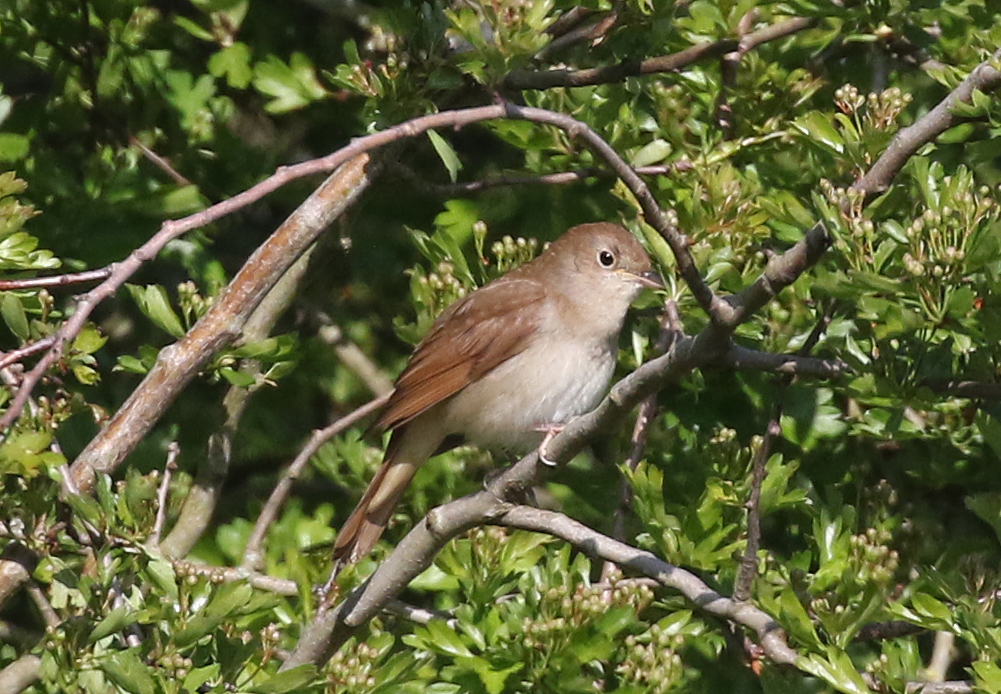
A third Nightingale was now singing a bit further over, on and off. This one is in a very thick area of scrub and we thought we were unlikely to see it, but we walked over and stood on the path nearby. As we were listening to it, it flew in and landed in a tree much closer to us. It was half hidden behind the emerging leaves, but we got it in the scope too, before it dropped back down into the undergrowth.
A pair of Linnets were flitting around in the bushes by the path. The female flew in and landed very close to us, carrying some dried grass in its bill, presumably trying to build a nest in the bushes, so we moved away.
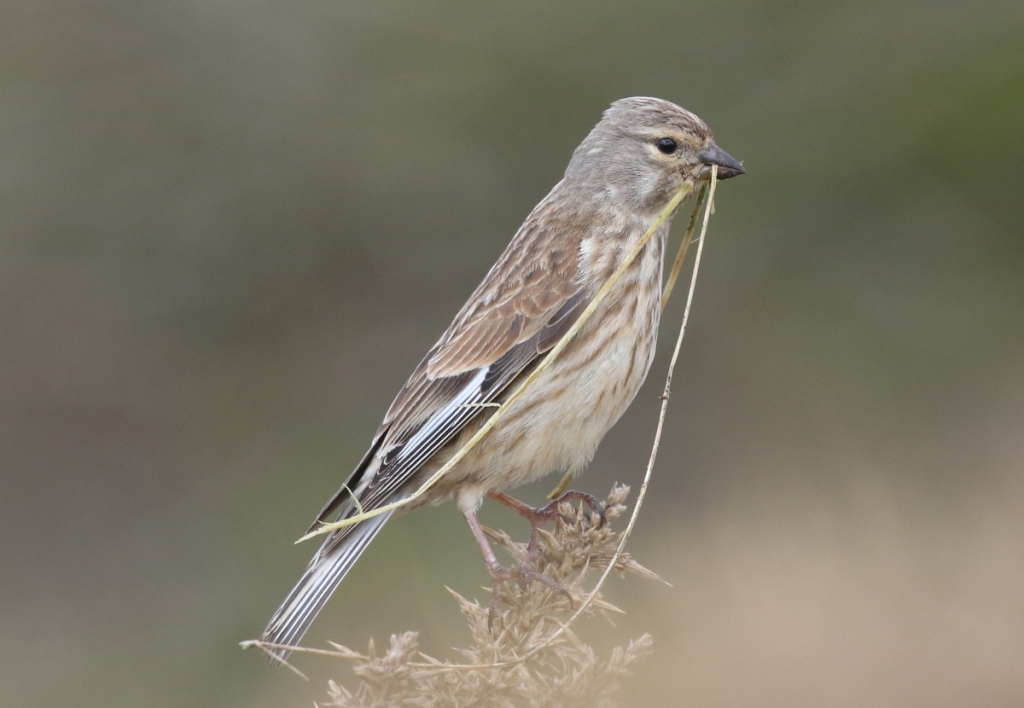
Having heard several and had great views of two different Nightingales, we decided to explore more of the site to see what else we could find. A Lesser Whitethroat was singing in a low hawthorn ahead of us, a rattling song but this one had added a short scratchy warble to the end. As we walked up we could see it working its way through the leaves, and it came right out onto the sunny side in front of us.
Lesser Whitethroats can be very hard to see, as they tend to hide deep in dense thorny bushes, but this one had obviously not read the manual. We had fantastic prolonged views of it, as it picked around the flower buds on the ends of the branches. It was obviously finding lots of food there.
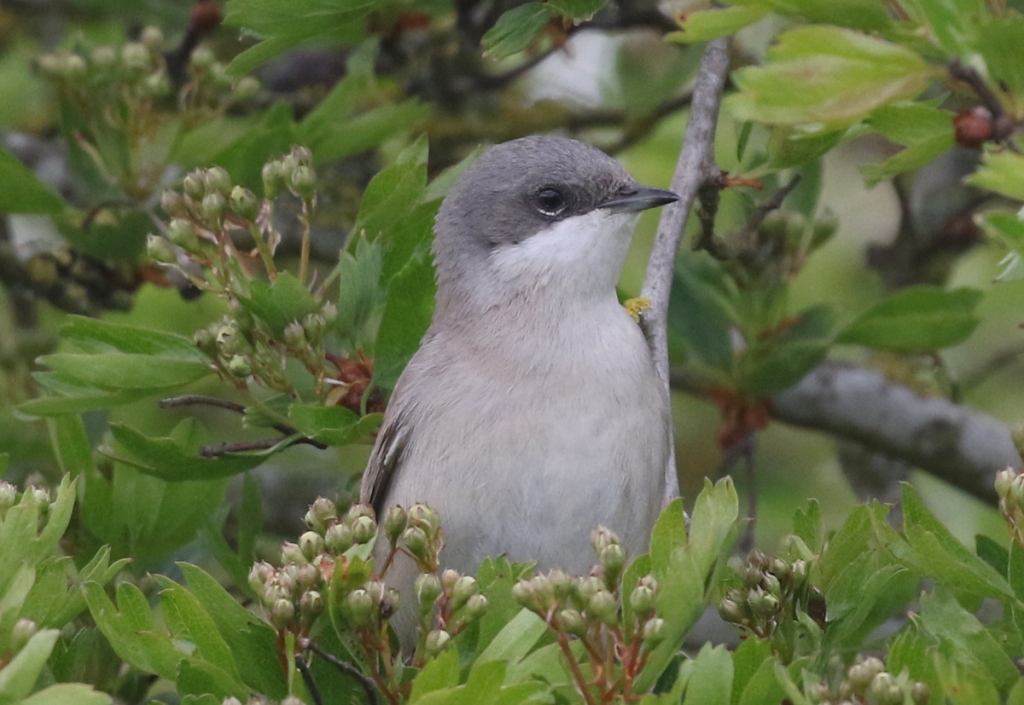
When we eventually moved on again, a Common Whitethroat was feeding in another low hawthorn nearby. A good comparison with the Lesser Whitethroat we had just been watching, we could see the browner upperparts and bright rusty edges to its wing feathers. Two Yellowhammers appeared in the same bush with it.
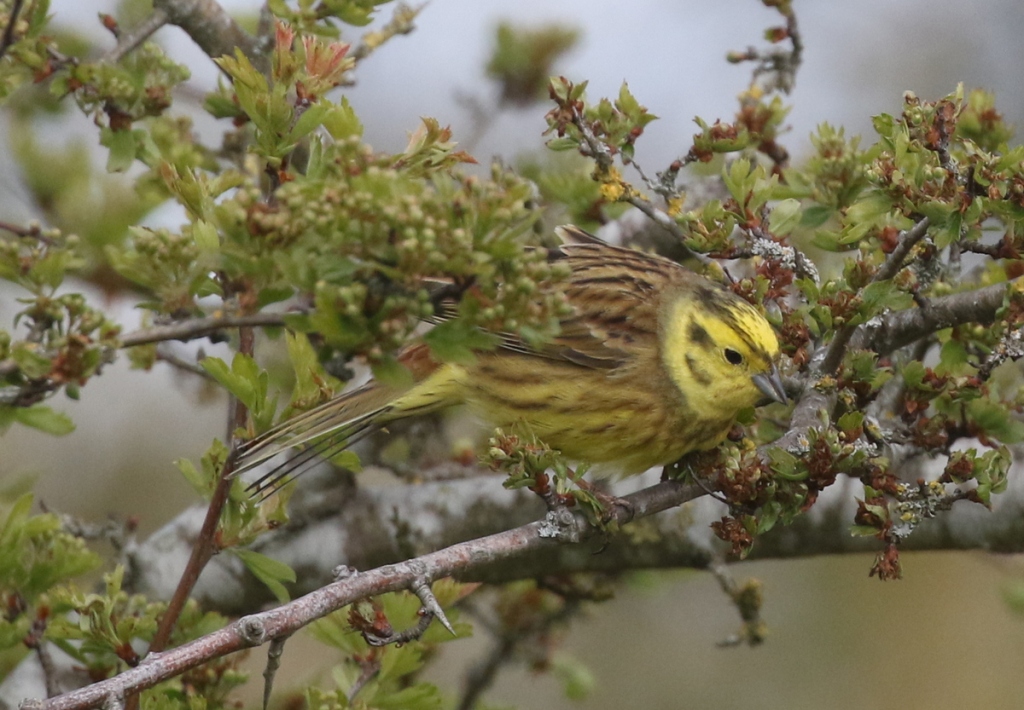
Another Nightingale was singing just ahead of us, so we stopped again. This one was hard to see, moving round, and after a while we realised that it was singing from down on the ground. As we walked on round the bushes, it flew up from in amongst some low mahonia and disappeared back into the bushes. A Cuckoo was singing in the distance behind us.
We stopped again in another area favoured by Nightingales, a small bowl of trees and a sunny edge out of the wind. Sure enough, one was singing from the dense privet understory here too. We waited to see if it might come out onto the edge. Several Starlings were zooming around between the trees and one landed on the open grass, collecting insects in its bill.
The Nightingale wasn’t coming out, and appeared to move deeper in, so we walked round to the other side of the trees. We had a couple of brief glimpses as it flew between the bushes or dropped down to the ground briefly underneath. Then it flew into a particularly dense area of privet, and launched into full song. We stood for a while and listened to the amazing variety of the phrases – beautiful melodic whistles, gurlges, clicks – interspersed with pauses in between. Unforgettable!
The Nightingales had certainly exceeded themselves today – at least seven singing males heard and two seen well. We decided to call it a wrap. We walked back to the cars past a large paddock, where two Grey Partridges were feeding, with a Skylark singing overhead. Lots of Brown Hares were over in the next field beyond. A Kestrel was hovering nearby over the verge, its head perfectly stable as it focused intently on the ground below.

The original idea was to head to Lakenheath Fen for the afternoon, but now there was a change of plan. Instead, we made our way back into Norfolk, towards Thetford Forest. A Barn Owl was out hunting by the road as we passed, despite it now being close to the middle of the day.
We stopped briefly at Weeting to use the facilities. The hides were occupied (and you have to book in advance at the moment), so we had a quick scan of the fields but there was no sign of the Stone Curlews – presumably they were tucked down somewhere out of view, asleep. Two regular (Eurasian) Curlew were out on the grass though, with several Swallows hawking back and forth too.
Our next destination was Santon Downham, hoping to find Crossbills here. A pair of Stock Doves was on the lawn of one of the houses as we walked down to the bridge. We could see a pair of Mandarin just upstream, so we walked down to get a closer look. Another pair of Mandarin flew over calling, and disappeared off towards St Helen’s.
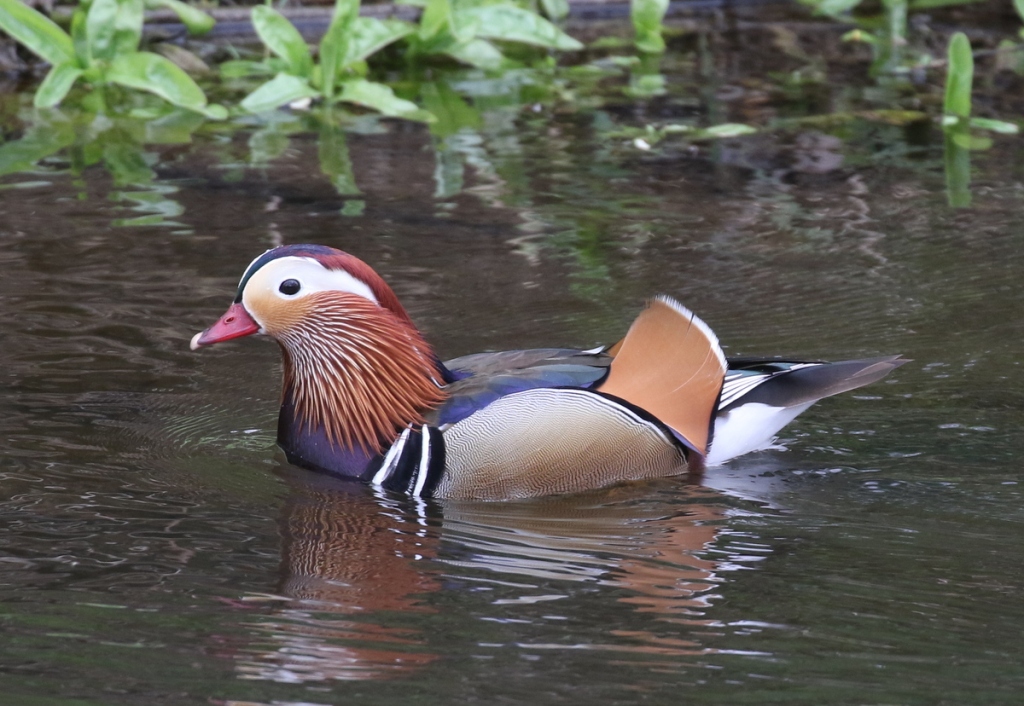
Back by the bridge, a couple of Marsh Tits were flitting round in the low trees across the river. A Treecreeper appeared too, working its way up the trunk of a small elder. A male Siskin started singing and we watched it songflighting overhead. We heard a Crossbill, but it flew over the trees calling where we couldn’t see it. At least it meant there were still some around!
A Grey Wagtail was singing just the other side of the bridge. It was perched in a low tree by the path, but flew before we spotted it. Thankfully it landed on a tangle of branches in the middle of the river, where we could get a better look at it.
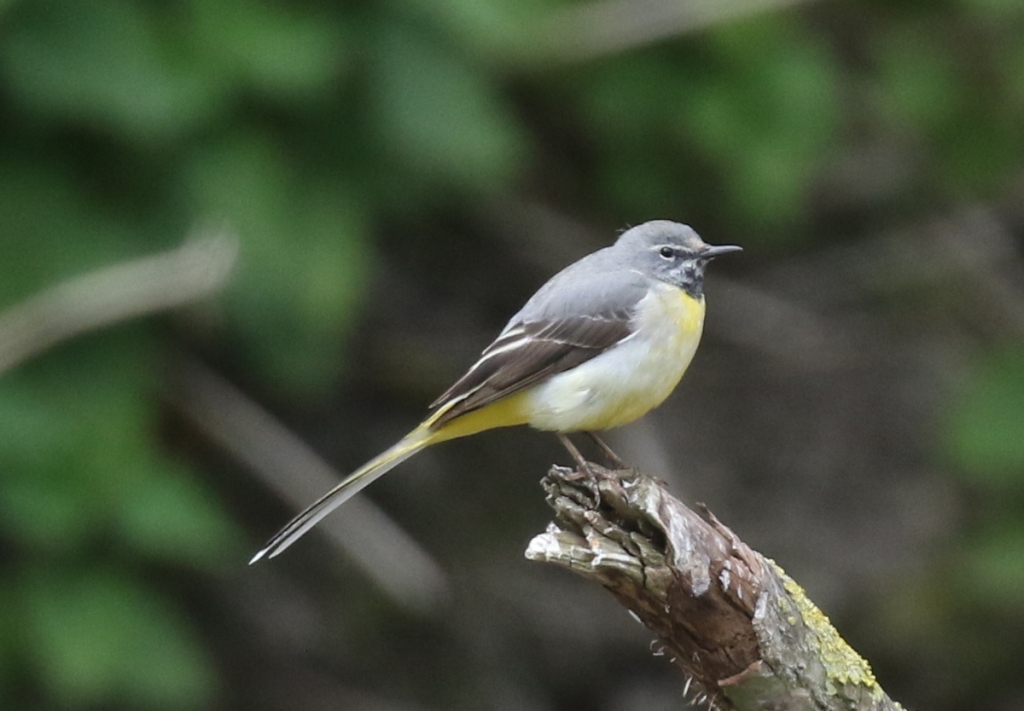
Another pair of Mandarin were on the river along here too. As we approached the tangled remains of a fallen tree in the river, a Kingfisher shot off ahead of us in a flash of electric blue. Another Crossbill flew over calling, but again we couldn’t see it for the trees. We could hear tapping across the river and eventually a Great Spotted Woodpecker flew out. A smart male Reed Bunting perched up in a small sallow on the bank ahead of us. There were not many insects out today – this cold spring we are having this year has really held back activity – but we did see a Large Red Damselfly along the river bank.
When we heard the next Crossbill calling overhead, this time we looked up to see it land in the top of one of the poplars overhanging the path. More flew in, a small flock, and now we could see at least ten Crossbills perched in the tree high above our heads. We got them in the scope – we got them in the scope and could see their distinctive crossed mandibles and a good view from underneath of the dark arrowheads on their undertail coverts.
We watched them for a while. Some of the Crossbills appeared to be feeding on the poplar flowers, others dropped down through the branches and started picking at the bark. One or two were very red males, others were orange, some with patches of yellow, and quite a few were green. The colour in Crossbills derives at least in part from their diet, but it was clear there were quite a few immature birds in the flock. Then suddenly they all flew off, and we realised there had been at least thirty of them spread over the tops of several of the poplars.
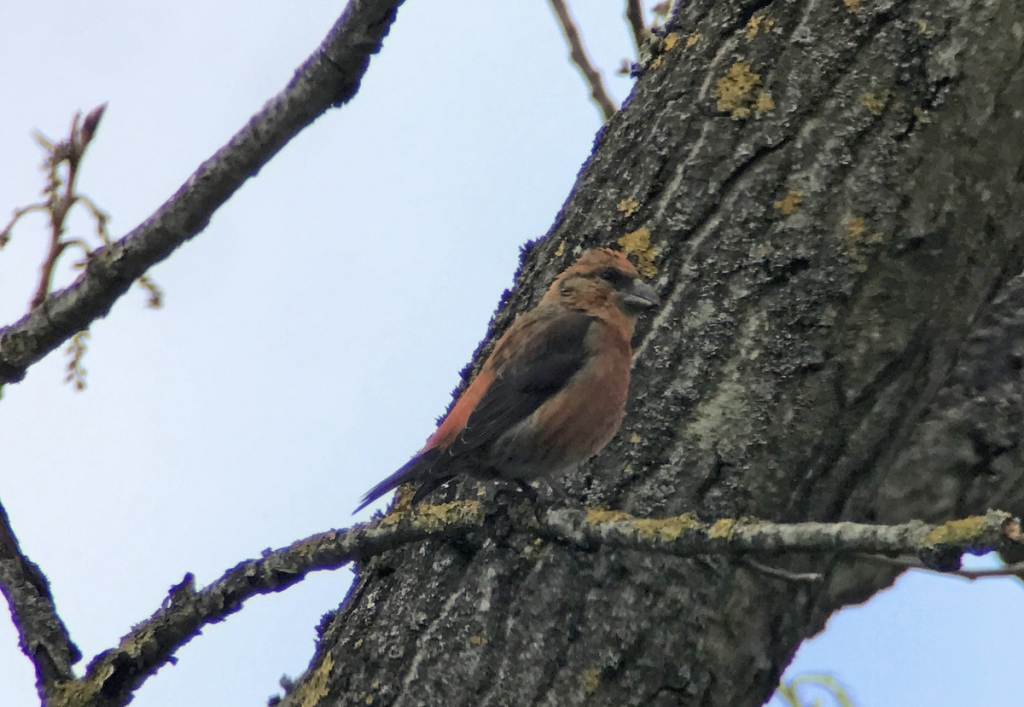
Mission Crossbill accomplished, we were getting hungry now. On the walk back, we heard a late Brambling calling, which flew out of the trees and over the river. The Grey Wagtail was still feeding around the tangle in the river, before flying a little further up and then flycatching from a bare branch overhanging the water. Then it was back for a late lunch on the bench in the car park.
To finish the day, we headed round to Lynford. We were hoping to find a Firecrest but walking round the Arboretum it was very quiet now – they are always most vocal earlier in the day and we had hit the mid afternoon lull. We tried several different places where we know they are, but a single Goldcrest was the best we could locate now. Continuing down to the lake, we could hear a Little Grebe laughing, and looking into the reeds we could see one on a nest platform built between two bulrush stems.
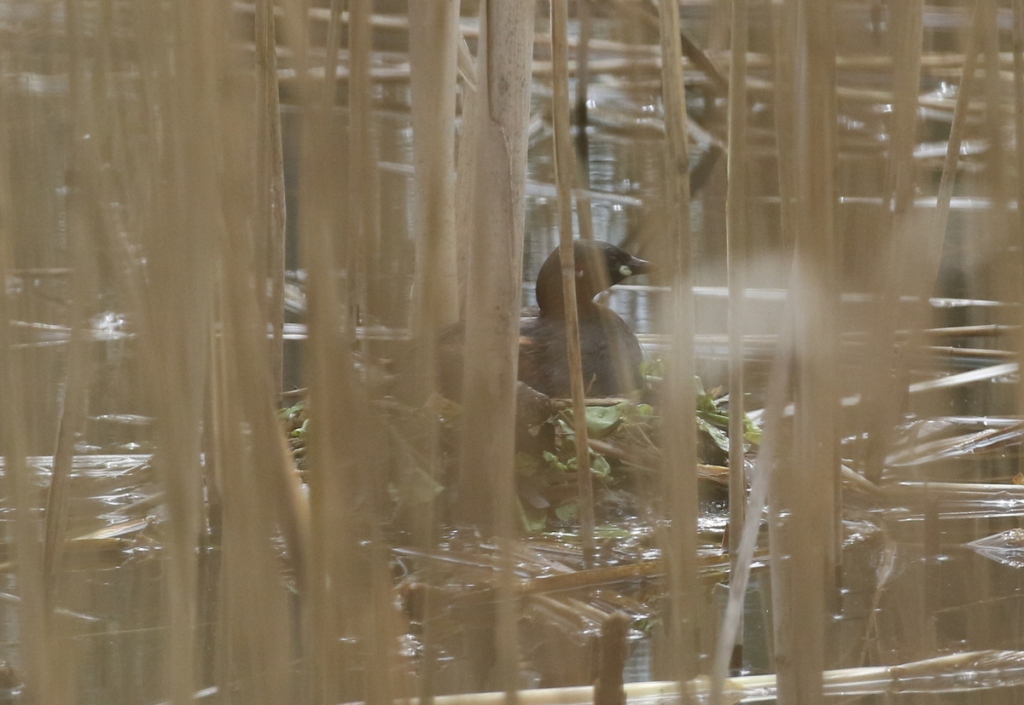
There was more activity down at the bridge, with food having been put out on the brick pillars again. A succession of tits flew in and out, including one or two Marsh Tits. A Nuthatch flew into the trees nearby and watched for a while, before flying down and grabbing a couple of sunflower seeds, which it then took back into the trees to wedge into the bark for later.
We heard more Crossbills calling in the tops of trees high above, which dropped down out of view. When we got to the pool just over the bridge, three were perched in the low trees by the water. There were a couple more in the trees nearby and one by one they dropped down to the waters’ edge to drink. It is thirsty work feeding on pine seeds. Then as quickly as they had appeared, they were off across the paddocks opposite.
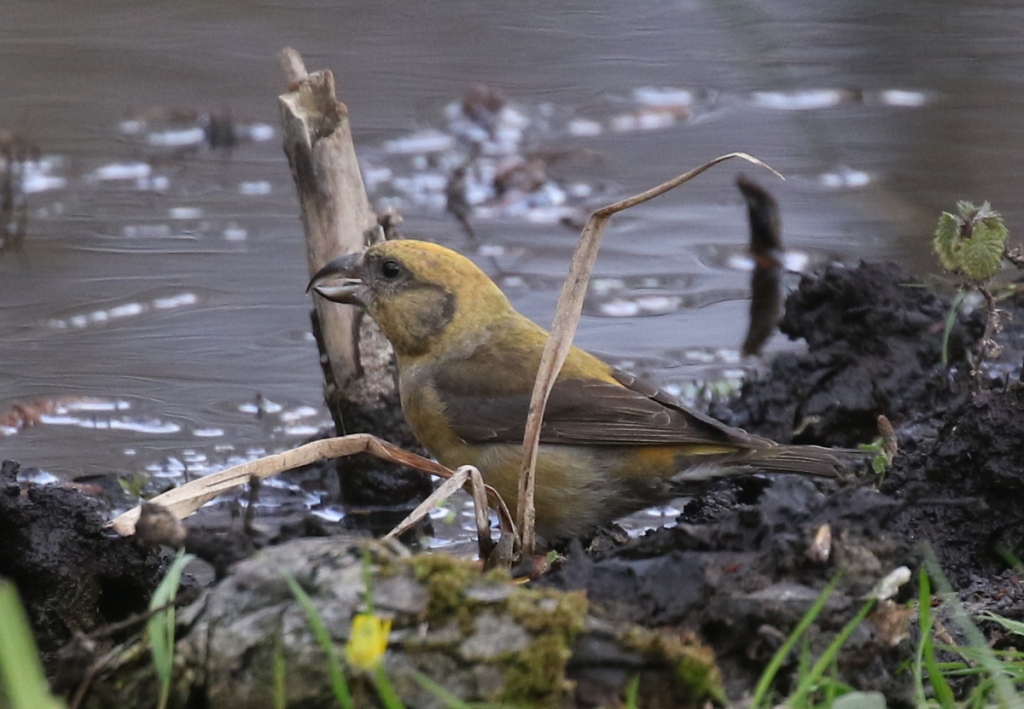
There were three Grey Wagtails around the pool too, flycatching over the warer, and one or two Pied Wagtails as well. A Song Thrush dropped down to the near bank of the water and a Mistle Thrush flew up briefly into the trees. A Garden Warbler was hopping around on the edge of the trees just beyond the water. Two or three Siskins were chasing round the trees by the bridge and a nice bright male perched in the top of an alder by the path to sing.
Then it was time to call it a day and head back.
